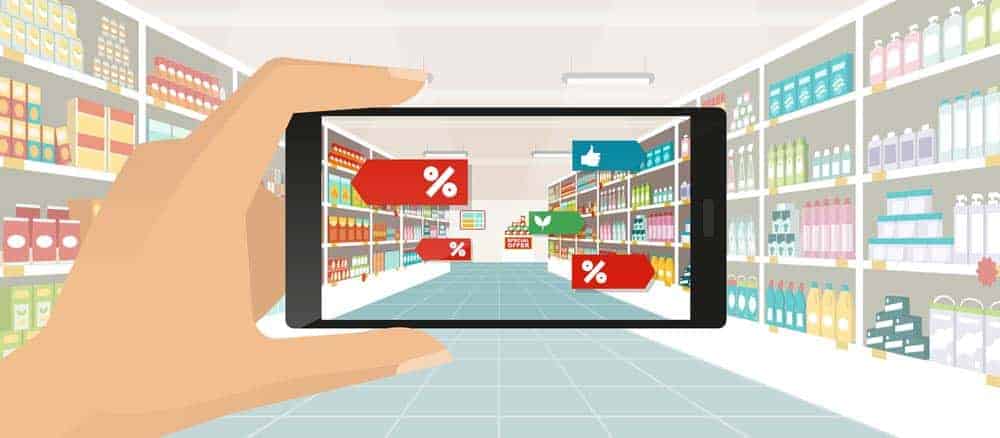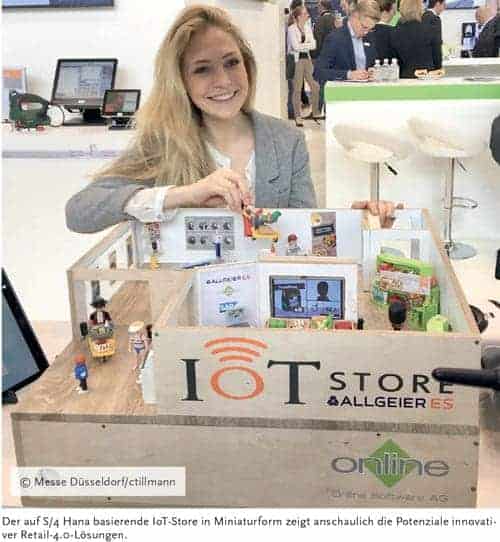Point of Experience


Networking is increasingly becoming the central driver for digital and mobile transformation. In this context, the speed within commerce in particular is picking up rapidly and there are no signs of slowing down.
Innovative concept studies as a process model
Allgeier SAP Retail Innovation Lab aims to explore and develop new ideas and solutions for the retail industry together with its customers in an innovative and agile environment.
New process approaches for digital and mobile transformation show how the new, disruptive technologies can be used profitably for customers.
For example, when customers enter the store, they can be identified via their smartphone and guided via indoor navigation to products they have expressed interest in online in advance.
In addition, recurring customers can be identified and employees can provide more targeted advice with information about their purchase history or preferences.
IoT: Opportunities for Retail?
 At the EuroShop 2017 retail trade fair, it became clear that the trend and the interest of retailers regarding the Internet of Things in retail is increasing.
At the EuroShop 2017 retail trade fair, it became clear that the trend and the interest of retailers regarding the Internet of Things in retail is increasing.
In the retail sector in particular, the increasing digitization of retail stores and the possible networking of items with each other and with the user offer huge potential for innovation with great added value.
From networked, intelligent shelves and smart lighting to the networking of store technologies and predictive systems. In retail, the Internet of Things is designed to support consumers in their shopping without being distracting or even noticeable.
In concrete terms, this means that smart sensor technology enables employees to be located where the customer needs them for advice. Or customers can call a customer advisor via mobile devices or wearables.
Today, it is already possible with SAP resources to conduct location-based marketing in real time using technologies such as beacons, RFID, cameras, or intelligent lighting systems.
Camera systems recognize a person's age, gender or mood. Based on the recognized customer profile, the system calculates an individually suitable advertisement and adjusts the display of a digital signage screen located near the customer in real time.
Intelligent shelves automatically detect the inventory situation and with temperature sensors, monitoring of the refrigeration units (e.g. with notification on a smartwatch) is possible, detecting withdrawals, error situations or shelf life.
Out-of-stock situations can be avoided based on predictive analyses. Customers have the advantage of being able to query local inventories more precisely and reserve products on the move at any time.
Motion sensors, infrared sensors or beacons can be used to create customer movement profiles. This can be used to optimize the placement of offers or the layout of stores. Real-time navigation in large shopping centers is also possible with these new technologies.
Smart home technology will gradually bring the point of sale to our homes. In the future, the smart refrigerator will automatically create a shopping list as soon as the products run low.
What sounds like science fiction is in fact not far off. Amazon is showing us the first signs of this with "Amazon Dash," a physical order button that allows daily necessities to be automatically reordered at the push of a button.
Mini IoT Store based on S/4
Allgeier's miniature IoT store is based on S/4 Hana and demonstrates some of these particularly promising solutions in a clear and easy-to-understand manner: including data-based in-store promotion and face tracking advertising.
 The future of POS customer targeting lies in the individualization of offers and the display of advertising content that is really relevant and therefore interesting for the customer, whether based on RFID-tagged merchandise, smartphone or app profile data, or on the basis of age and gender.
The future of POS customer targeting lies in the individualization of offers and the display of advertising content that is really relevant and therefore interesting for the customer, whether based on RFID-tagged merchandise, smartphone or app profile data, or on the basis of age and gender.
Another concept deals with voice interfaces such as Amazon Alexa, Microsoft Cortana, Apple Siri, etc. With the help of these new technologies, a completely new communication channel to the customer opens up.
Search and ordering processes are being radically simplified and require retailers to come up with new concepts in order to keep up with the huge competition from online retailers.
Our Pick-up in Store prototype is an example of how this change can be expressed. This allows customers to initiate an order process via Alexa and to systematically browse a Big Data cluster for recipes based on preferences, keywords and ingredients.
A sales order is then created based on the recipe - and this, of course, takes into account the home inventory, which is calculated from smart home and shopping behavior.
The order is sent to the desired store, where the ordered goods are picked accordingly. When the customer approaches the store, his order is placed directly ready to take away, thus avoiding unnecessary waiting times.
In the Allgeier model, the license plate number is recognized by a camera, assigned to the customer orders in the SAP system and this information is transferred to a shelf robot. This robot automatically selects the goods prepared for the customer and delivers them ready to be taken away.
Big Data and privacy
The more data, historical and predicted, that is available as a basis, the better and more individualized the offers or process support can be designed. In projects, for example, we integrate weather data or local sports and cultural events.
This data is used on the one hand to play out individual offers and on the other hand to support employees in their decision-making.
In order to exploit the full potential, it must be clear that a high level of transparency must be ensured vis-à-vis the customer. Especially with regard to sensitive topics such as data protection and data security.
Customers will only provide their data if it is handled very carefully and a perceived sense of security is created through transparency.
It is also important that the collected values are not only used for "dashboarding". Rather, the data treasure lying dormant here should be lifted and have a process-related influence.
In a Predictive Data Driven Enterprise, for example, employees receive automated support in workforce scheduling, procurement processes or action planning.
Decisions are no longer made on the basis of gut instinct, but are supported by predictive models and statistically proven.
Bridge between infinite things
Technologically, it is necessary to minimize a supposedly high investment requirement with a clever architecture.
In a cooperation with technology providers, a generic middleware and intelligent predictive analytics or machine learning algorithms, Allgeier has bridged the gap between infinite things, the SAP world and trade processes.
The potential of Retail 4.0 is huge if retailers succeed in putting the customer at the center and offering them added value.





